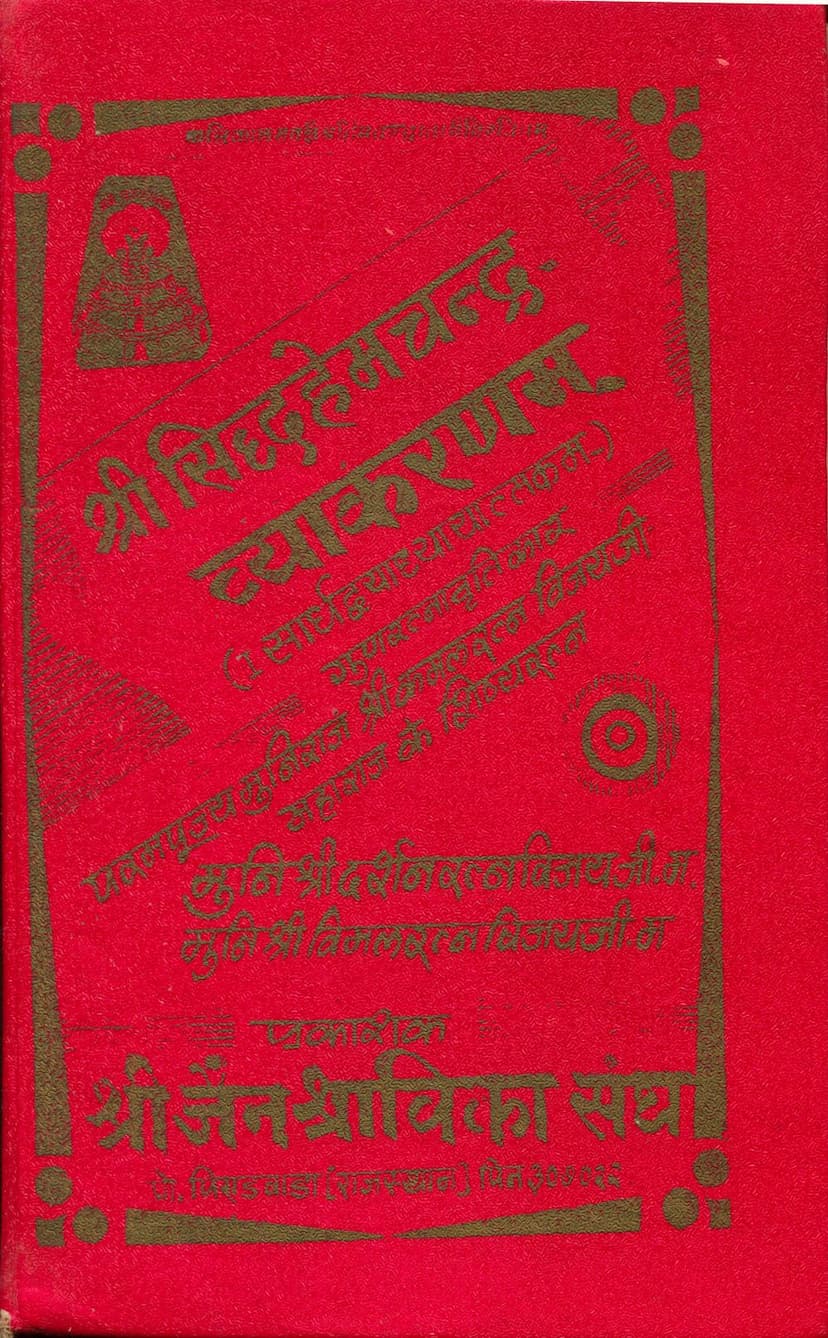Siddh Hemchandra Vyakaranam Part 01
Added to library: September 2, 2025

Summary
Here's a comprehensive summary of the provided Jain text, focusing on Part 1 of "Siddh Hemchandra Vyakaranam" by Darshanratnavijay and Vimalratnavijay, published by Jain Shravika Sangh:
Overall Purpose and Nature of the Text:
This text is identified as the first part of "Siddh Hemchandra Vyakaranam," a significant work in Jain grammar attributed to the venerable Acharya Hemchandra. The publication is presented with the "Swopadnya Laghuvritti" (author's own short commentary) and "Gunaratnavritti" (a commentary by Kamalratnavijayji, compiled by Darshanratnavijayji and Vimalratnavijayji). The text is substantial, spanning two and a half chapters. It aims to explain and elaborate on the grammatical rules established by Acharya Hemchandra.
Key Content and Structure (Based on the provided pages):
The provided pages (1-10) cover the initial foundational aspects of the grammar, likely the introductory sections of the first part of the work. The content appears to follow a logical progression typical of grammatical texts:
-
Preamble and Dedication (Pages 1-6):
- Title and Authorship: Clearly states the title "Shri Siddh Hemchandra Shabd Anushasanam" and credits the author as Kalikal-Sarvagya Shri Hemchandracharya. It highlights the commentaries involved: Swopadnya Laghuvritti, Gunaratnavritti, and mentions the compilers/authors as Munishri Darshanratnavijayji M. and Munishri Vimalratnavijayji M.
- Publisher: Jain Shravika Sangh, Piṇḍwāḍā, Rajasthan.
- Dedication: The text is dedicated to Param Pujya Kalikalkalpataru Acharya Dev Shri Vijay Ramchandra Surishwarji Maharaj, acknowledging the guidance of Param Pujya Pananyas Pravar Shri Jitenra Vijayji Ganivarya and the authorship of Munishri Darshanratnavijayji M. and Munishri Vimalratnavijayji M.
- Acknowledgements: Several individuals and institutions are thanked for their contributions to the publication, including the Piṇḍwāḍā Sangh, the author's spiritual brothers, and those who provided financial or logistical support.
- Biographical Information: A significant portion (Page 4) is dedicated to a biographical sketch of Acharya Shri Vijay Premsuriji Maharaj, detailing his spiritual journey, dedication to study, and role in resolving important doctrinal matters. This highlights the lineage and reverence associated with the presented work.
- Content Structure: An index is provided, indicating the multi-part nature of the entire "Siddh Hemchandra Vyakaranam," with Part 1 covering "1 to 10 Padas" (sections/chapters).
- Inspirational Message: There are philosophical and devotional messages related to the pursuit of knowledge and spiritual upliftment.
-
Grammatical Principles and Sutras (Pages 8-10):
- Invocation/Mangalam (Page 8): The text begins with an invocation, "Pranamya Paramatmanam, Shreyah Shabd Anushasanam," and invokes Lord Parshvanath, indicating the auspicious start to the grammatical exposition.
- Meaning of "Arham" (Page 8): The initial word "Arham" is explained as a divine name, signifying the supreme being, and its importance for auspicious beginnings in the scripture.
- Definition of "Siddh" (Page 10): The text emphasizes that "Siddhih Syad Vadaat," meaning accomplishment and perfection in grammar stem from the "Syad-vada" (the Jain doctrine of conditional predication or anekanta-vada, the doctrine of manifold aspects). This highlights the philosophical underpinnings of Jain grammar.
- Understanding of "Lokat" (Page 10): It is stated that the understanding of unmentioned grammatical terms and rules ("sanjna," "paribhasha," "adhikara," etc.) is derived from "lokat" (convention, common usage, or established scholarly practice).
- Classification of Sutras: It mentions that sutras are categorized into ten types: sanjna (designation), paribhasha (definition/rule), adhikara (topic/section), vidhi (rule), pratishedha (prohibition), niyama (regulation), vikalpa (option), samuchchaya (conjunction), atidesha (analogy/extension), and anuvada (reiteration).
- Introduction to Vowel and Consonant Classification (Pages 12-17): The initial grammatical rules focus on the classification of Sanskrit vowels (swara) and consonants (vyanjana) according to Jain phonetic principles, likely derived from or aligned with Brahminic traditions but adapted to Jain linguistic philosophy.
- Vowels (Swara): Defines vowels and their properties like मात्रा (duration/mora). It lists the vowels (a, ā, i, ī, u, ū, ṛ, ṝ, l, ḷ, e, ai, o, au) and introduces concepts like हस्व (short), दीर्घ (long), and प्लुत (prolated).
- Consonants (Vyanjana): Lists the consonants (k, kh, g, gh, ṅ, etc.) and introduces their classification based on articulation points and efforts (sthana and prayatna).
- Special Vowels/Sounds: Discusses अनुस्वार (anusvara) and विसर्ग (visarga).
- Sandhi Principles: Begins to touch upon the rules of sandhi (joining of sounds), particularly with vowels like the combination of 'a' with 'i', 'u', 'ṛ', 'l', 'e', 'ai', 'o', 'au'.
Key Jain Philosophical Concepts Mentioned:
- Syad-vada/Anekanta-vada (Manifold Aspects): The text explicitly links grammatical perfection ("siddhih") to Syad-vada, suggesting that the understanding of linguistic rules and the relationship between words and their meanings is rooted in the Jain philosophy of conditional existence and multiple viewpoints.
- Reverence for Acharya Hemchandra: The work is presented with immense respect for Acharya Hemchandra, referring to him as "Kalikal-Sarvagya" (omniscient in the present age) and highlighting his profound knowledge.
- Spiritual Lineage: The detailed biographical information about Acharya Premsuriji Maharaj and the dedication to Acharya Ramchandra Surishwarji Maharaj emphasize the importance of spiritual succession and guidance in Jain tradition.
In essence, this first part of the "Siddh Hemchandra Vyakaranam" serves as an authoritative and reverent introduction to Jain grammatical principles, grounding them in philosophical understanding and acknowledging the rich lineage of Jain scholars. It lays the groundwork by defining fundamental elements of language like vowels and consonants, while simultaneously embedding Jain philosophical concepts like Syad-vada into the very fabric of linguistic analysis.